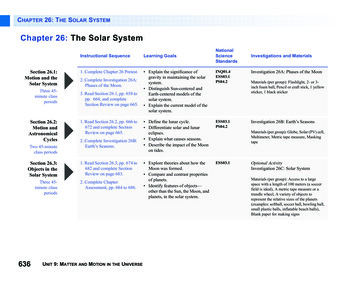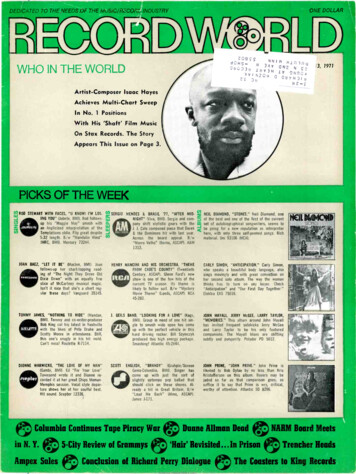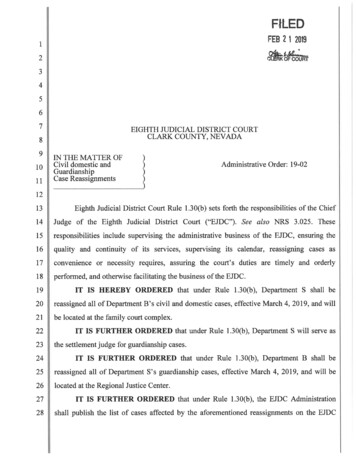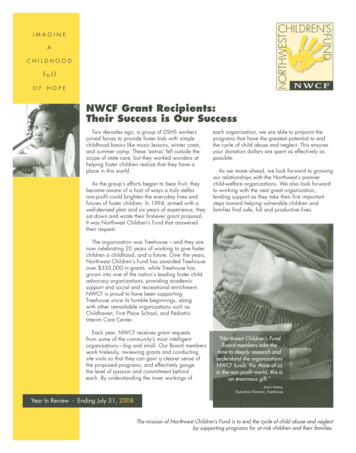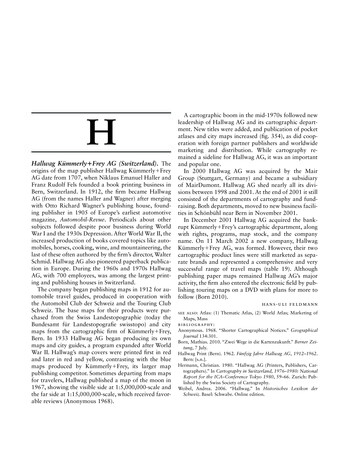
Transcription
HHallwag Kümmerly Frey AG (Switzerland). Theorigins of the map publisher Hallwag Kümmerly FreyAG date from 1707, when Niklaus Emanuel Haller andFranz Rudolf Fels founded a book printing business inBern, Switzerland. In 1912, the firm became HallwagAG (from the names Haller and Wagner) after mergingwith Otto Richard Wagner’s publishing house, founding publisher in 1905 of Europe’s earliest automotivemagazine, Automobil-Revue. Periodicals about othersubjects followed despite poor business during WorldWar I and the 1930s Depression. After World War II, theincreased production of books covered topics like automobiles, horses, cooking, wine, and mountaineering, thelast of these often authored by the firm’s director, WalterSchmid. Hallwag AG also pioneered paperback publication in Europe. During the 1960s and 1970s HallwagAG, with 700 employees, was among the largest printing and publishing houses in Switzerland.The company began publishing maps in 1912 for automobile travel guides, produced in cooperation withthe Automobil Club der Schweiz and the Touring ClubSchweiz. The base maps for their products were purchased from the Swiss Landestopographie (today theBundesamt für Landestopografie swisstopo) and citymaps from the cartographic firm of Kümmerly Frey,Bern. In 1933 Hallwag AG began producing its ownmaps and city guides, a program expanded after WorldWar II. Hallwag’s map covers were printed first in redand later in red and yellow, contrasting with the bluemaps produced by Kümmerly Frey, its larger mappublishing competitor. Sometimes departing from mapsfor travelers, Hallwag published a map of the moon in1967, showing the visible side at 1:5,000,000-scale andthe far side at 1:15,000,000-scale, which received favorable reviews (Anonymous 1968).A cartographic boom in the mid-1970s followed newleadership of Hallwag AG and its cartographic department. New titles were added, and publication of pocketatlases and city maps increased (fig. 354), as did cooperation with foreign partner publishers and worldwidemarketing and distribution. While cartography remained a sideline for Hallwag AG, it was an importantand popular one.In 2000 Hallwag AG was acquired by the MairGroup (Stuttgart, Germany) and became a subsidiaryof MairDumont. Hallwag AG shed nearly all its divisions between 1998 and 2001. At the end of 2001 it stillconsisted of the departments of cartography and fundraising. Both departments, moved to new business facilities in Schönbühl near Bern in November 2001.In December 2001 Hallwag AG acquired the bankrupt Kümmerly Frey’s cartographic department, alongwith rights, programs, map stock, and the companyname. On 11 March 2002 a new company, HallwagKümmerly Frey AG, was formed. However, their twocartographic product lines were still marketed as separate brands and represented a comprehensive and verysuccessful range of travel maps (table 19). Althoughpublishing paper maps remained Hallwag AG’s majoractivity, the firm also entered the electronic field by publishing touring maps on a DVD with plans for more tofollow (Born 2010).H ans -Uli Feldm annSee also: Atlas: (1) Thematic Atlas, (2) World Atlas; Marketing ofMaps, MassB i b l i o g r a p h y:Anonymous. 1968. “Shorter Cartographical Notices.” GeographicalJournal 134:301.Born, Mathias. 2010. “Zwei Wege in die Kartenzukunft.” Berner Zeitung, 7 July.Hallwag Print (Bern). 1962. Fünfzig Jahre Hallwag AG, 1912–1962.Bern: [s.n.].Hermann, Christian. 1980. “Hallwag AG (Printers, Publishers, Cartographers).” In Cartography in Switzerland, 1976–1980: NationalReport for the ICA–Conference Tokyo 1980, 59–66. Zurich: Published by the Swiss Society of Cartography.Weibel, Andrea. 2006. “Hallwag.” In Historisches Lexikon derSchweiz. Basel: Schwabe. Online edition.
574Hammond Map CompanyFig. 354. DETAIL FROM HALLWAG’S BERN/BERNE1:13,000, 1983. City map with public transport routes, mapof surroundings. Protected by its glossy card cover printed inHallwag’s signature red and yellow, this map unfolds to showthe city and to aid the traveler further with inset maps at various scales, a multilingual key to symbols, and a street index.Table 19. Map output of Hallwag Kümmerly Frey,first decade of the twenty-first centuryMap Type (total)HallwagKümmerly FreyRoad maps (57)1938European regional roadmaps (39)39Road atlases (14)14City maps in conventionalfolding format (33)25City flash maps inaccordion-fold format (17)17Hiking maps (58)25Bicycle maps (21)83321Size of the entire map, unfolded: 67.5 82.7 cm; size ofdetail: 29.5 41.8 cm. Permission courtesy of HallwagKümmerly Frey AG, Schönbühl.Hammond Map Company (U.S.). Caleb StillsonHammond, a former sales representative for Rand McNally & Company, founded C. S. Hammond & Company in 1900, allegedly because of a salary dispute withthe Chicago publisher. Within a decade his New Yorkfirm became one of the leading map publishers in theUnited States, issuing maps, atlases, globes, and “geographical appliances” of every description. Hammond,who was born in Vienna, Austria, on 27 November 1862and died in New York City on 14 December 1929, formally incorporated his company in 1901, just after heissued his first publication, The Handy Cook Book. Theauthor, Marion Harland, a celebrated writer and household expert, had passed the zenith of her fame, and thevolume did not meet great success. This experience perhaps pushed Hammond to focus on publishing maps, a
Hammond Map Company575business in which he had twenty years of experience. In1903 he produced two of his early maps, Hammond’sComplete Map of [the] Republic [of] Panama and TheClyde Steamship Co. Map of Florida Showing Routesand Railroad Connections. Both were folded maps, andeach heralded a key ingredient in the firm’s later success: supplying popular maps of places in the news andproducing maps on demand for a variety of commercialventures.During the first decade of the company’s existence itpublished a variety of cartographic products, including a New and Complete Map of Cuba (1906), a Complete Map of [the] Panama Canal (1907), Hammond’sAtlas of New York City and the Metropolitan District(1907), Hammond’s Alaska-Yukon-Pacific Atlas (1909,in several versions, including one for the Bon Marchedepartment-store firm), and Hammond’s Atlas of theState of Washington, published for D. A. Hollowell in1909, a substantial volume of over a hundred pages featuring both maps and pictures.The Crossroads of the Pacific, a wall map on rollersattributed to Hammond and dated about 1908, is a circular map of the Pacific Ocean with Honolulu in thecenter, dramatically highlighted by the lines of shippingroutes extending in every direction. This map, “Compiled for the Hawaii Promotion Committee,” includeddata from 1907 in the marginal notes and utilized theMercator projection to exhibit a design quality far exceeding a similar, but much smaller, map on page 54 ofHammond’s Commercial and Library Atlas of the World(1912). The atlas version, The Pacific Ocean ShowingDistances between Hawaii and Principal Ports, straightened the lines of the shipping routes, cluttered the image with detail, and assumed the look of a mechanicallyproduced map rather than an artistic rendering. However bland, the atlas version pointed out the directionHammond would go over the next century: producingready-made commercial maps for the mass market following a rather ordinary standard format rather thancarefully designed custom-made maps designed for particular projects (fig. 355). Atlases in particular propelledthe publishing house into national prominence.It appears that Hammond issued its first general atlas,a small (33.5 26 cm), 144-page collection of 142 colormaps, in 1905. Subsequent editions of Hammond’sModern Atlas of the World appeared yearly up to 1932.By then the firm regularly produced a complete list of atlas products addressing a variety of reference needs andFig. 355. PHOTOGRAPH OF THE HAMMOND EDITORIAL DEPARTMENT.Size of the original: 10.4 17 cm. From Maps 1950, 13.
576Fig. 356. COVER OF MY FIRST WORLD ATLAS, 1963.Size of the original: 25.4 17.9 cm. From My First WorldAtlas (Maplewood, N.J.: Hammond, 1963).many budgets (fig. 356). The Commercial and Libraryatlas, which included the Hawaii map mentioned above,was an expensive, deluxe edition that combined severalHammond products, including a 1907 pamphlet on thePanama Canal.In 1911 Hammond opened a retail store in the HudsonTerminal to sell a variety of books and maps from otherpublishers as well as its own products. Among the latter, its General Catalogue of Maps, Atlases, MaproutingSystems, etc. (1916) reached 228 pages, and was soonjoined by a series of special catalogs featuring the firm’sown productions, including war maps (1917), schoolmaps (1920), and globes and map cabinets (1923). Inthe 1920s Hammond & Company became second onlyto Rand McNally as a publisher of maps for American audiences, regularly issuing road maps, referenceatlases, globes, and a variety of specialty cartographicitems for schools, newspaper stands, tourists, businesses,and libraries. In 1971 its seven trade-book atlases hadan initial press run of 400,000 copies compared to theHammond Map Companyequivalent initial printing of 633,000 atlases by RandMcNally. In that year Hammond turned out about a billion maps of all sorts, but only a fifth of the total forthe Chicago publisher, which then dominated the fieldof highway maps. In contrast to Rand McNally, whichhad its own printing facilities, Hammond did little production work at its own small plant and outsourced theprinting of its major atlases.Located at the center of American book publication,Hammond regularly supplied maps to other publishersfor their encyclopedias, yearbooks, dictionaries, textbooks, and reference books of every description. A series of small, simple maps helped a number of stationeryprinters dress up their otherwise bland diaries. Hammond’s “diary maps” proved to be quite profitable andfound many uses in a wide variety of publications. Theywere regularly updated so that publishers of every description could obtain them at a moment’s notice.The “Hammond look” of its “ready-made” maps andatlas pages featured an abundance of place-names, softcolors, railroad routes in red, contour lines highlightedby different shades of coloring, and an overall mechanical look. Hammond atlases tended to be less expensivethan competing volumes, which led to widespread distribution and impressive sales figures if not cartographicexcellence. As a promotional venture in October 1971,Hammond offered a free pocket atlas to anyone whosupplied a stamped, self-addressed envelope. Even so,the top-of-the-line atlases produced by Hammond wereoften deluxe editions. In 1971, for example, its 672-pageMedallion World Atlas, weighing a hefty nine pounds,sold for 24.95, in contrast to Rand McNally’s premiumCosmopolitan World Atlas, which had only 428 pagesin a larger format and sold for 19.95. In that sameyear Hammond also offered a Hallmark atlas in a fancybinding for 39.95, a small fortune at the time. The major selling point of Hammond maps was their scientificaccuracy, asserted by such design features as extendingthe contour lines of physical maps several miles offshoreto mark the continental shelf.In 1950 the firm’s Publisher’s Map Service Divisionissued a thirty-two-page prospectus outlining its services and reprinting sample maps from a dozen seriesof plates that it kept up-to-date for regular use by otherpublishers. The pamphlet emphasized the accuracy ofthe maps, their ready availability in a variety of sizes andformats, the ease of overprinting, the ability to vary thecoloring, various ways simple maps could be enhancedby adding color plates, and the firm’s employment of amodern indexing system using an IBM Electric PunchedCard Sorting Machine. Hammond even stocked a seriesof maps in Spanish “to satisfy a considerable demandin Spanish America” (Maps 1950, 29). When the firmsent its archive to the Library of Congress in 2002, a file
Harley, J(ohn) B(rian)577of over 12,000 cards documented the extent to whichHammond produced maps for other companies. Itssmall map of Jerusalem in biblical times, for example,appeared in dozens of publications.When Caleb D. Hammond, Jr., grandson of the company’s founder, took over the presidency of the firm in1948, he brought with him a degree in mechanical engineering. His interest in new technologies and the digitalproduction of maps pushed the company in those directions until it produced, in 1993, the first world atlas entirely generated by computer. Although the firm had traditionally been headquartered in New York City, someof its early imprints reported its home as Brooklyn. Inthe early 1950s the company relocated to Maplewood,New Jersey. Caleb Jr. stepped down as president in 1967and retired as chairman in 1974, but in the mid-1980s,when some family members wanted to sell the firm, heand his son C. Dean Hammond III acquired a controlling interest and orchestrated a large investment in electronic technology. In 1999 the Langenscheidt PublishingGroup purchased the privately held company and renamed it the Hammond World Atlas Corporation, afterward located in Springfield, New Jersey. At the timeLangenscheidt also owned several major American regional map publishers.In 2002, Langenscheidt donated the Hammond archives to the Library of Congress. The nearly 3,000atlases and maps with the Hammond imprint in the library’s collections, and the many thousands of bookscontaining Hammond maps, attest to the firm’s successin reaching its goal to publish “maps of every description for every conceivable purpose” (Maps 1950, 12).G e r a ld A . D anzerSee also: Atlas: (1) Thematic Atlas, (2) World Atlas; Marketing ofMaps, Mass; Rand McNally & Company (U.S.); Road Mapping:Road Mapping in Canada and the United States; Wall Map; Wayfinding and Travel Maps: Indexed Street MapB i bliogra p hy:Anonymous [W. M. F.]. 1954. “Along the Highways and Byways ofFinance.” New York Times, 24 October, F3.Burks, Edward C. 1971. “U.S. Atlas Giants Update the World.” NewYork Times, 28 September, 41 and 44.———. 1976. “Putting Hammond on the Map.” New York Times,24 October, 3 and 26.Flatness, James A. 2003. “Mapping the World: Library Receives Hammond Archives.” Library of Congress Information Bulletin 62,no. 5:103–5.Hammond Map Company. 1916–33. Eight catalogs in the pamphletfile of the Geography and Map Division, Library of Congress.Maps by Hammond. 1950. New York: C. S. Hammond & Company,Publishers Map Service Division.Rosenwein, Rifka. 1987. “Hammond Inc.’s New Chief Wants to KeepMap Maker in the Family.” Wall Street Journal, 2 March, 1.Harley, J(ohn) B(rian). The British historical geographer Brian Harley became the leading proponent of thepost-1980 move toward the critical study of cartography. He demonstrated the validity of a multicultural approach to map history through the early volumes of TheHistory of Cartography, coedited with David Woodward,and he influenced scholars in many disciplines with hispassionate and provocative essays on cartography asthe product of social power relations (most reprintedin Harley 2001). His intellectual trajectory exemplifiesthe changing intellectual climate of map studies in thesecond half of the twentieth century (see Edney 2005,133–43, for a comprehensive bibliography).Several obituaries and biographies narrate Harley’spersonal history (Woodward 1992; Edney 2005, 13–14;Laxton 2010). Born in 1932, he entered the University ofBirmingham in 1952 after national service in the army.He completed the BA in 1955 and the PhD in 1960;his dissertation addressed medieval settlement patterns.He taught at University of Liverpool (1959–69), workedbriefly as a sponsoring editor for David and CharlesPublishers (1969–70), and then returned to academiaat the University of Exeter in 1970. In 1986 he movedto the University of Wisconsin–Milwaukee. He died inMilwaukee in 1991.As a young lecturer, Harley created a new academicniche: the study of the large-scale topographical mapsof England and Wales that promised rich, largely unexplored evidence for the reconstruction of preindustriallandscapes. Specifically, he examined English countymaps (1750–1835) and the official Ordnance Surveymapping (after 1790); he would also come to study thelarge-scale mapping undertaken during the AmericanRevolution (1775–83). Harley evaluated their limits assources of geographical evidence by exploring the careers of their makers, the surveying techniques behindtheir production, the reasons for their preparation, andtheir consistency in representing each category of geographical feature (fig. 357). His goal was a refined appreciation that geometrical and topographical error potentially stemmed from multiple factors, not simply fromnegligent observation and measurement. He produced asubstantial scholarly corpus. In addition to essays andmonographs on particular surveys and maps, he prepared facsimile publications with lengthy introductionsto make the maps available to other researchers andguides to map history for lay researchers. He also prepared innovative methodological statements that soughtto codify the traditional processes of map interpretationaccording to historians’ established canons of criticism(Edney 2005, 19–31).In the 1970s, historical geographers’ use of early mapsto reconstruct the geographical concepts held by pastpeoples attracted Harley’s attention. In order to providemethod and rigor to such studies—so as to ensure thevalidity of arguments that certain maps represent a cul-
578Harley, J(ohn) B(rian)Fig. 357. LAND USE IN WORCESTERSHIRE, 1822. Harley’sreconstruction of early nineteenth-century land use in Worcestershire exemplifies his initial focus on assessing the worth oflarge-scale maps as evidentiary sources for historical geographers and other historians.Size of the original: 13.8 15.3 cm. From J. B. Harley, Christopher Greenwood: County Map-Maker, and His WorcestershireMap of 1822 (Worcester: Worcestershire Historical Society,1962), 45 (fig. 8). Permission courtesy of the WorcestershireHistorical Society.tural or social mind-set—Harley faced the problem ofinducing valid generalizations about map use from scattered and partial archival evidence. The models of cartographic communication then in vogue were not helpful:they conceptualized a closed system between mapmakerand map user. By contrast, Harley sought to understanddifferential access to maps, and that required the modeling of an open, social system. Lacking guidance in suchmodeling, Harley could only prepare a preliminary categorization of types of map use as suggested by the empirical record (Edney 2005, 33–50).Already dissatisfied with the character of the historyof cartography as a field of study, Harley’s growing appreciation of cartography as an open system could onlypersuade him further of the need for reform. By 1977 heand Woodward had decided to prepare a comprehensiveand inclusive work of reference around which a wellstructured discipline might coalesce. The result was TheHistory of Cartography, a multivolume work that wouldbecome the cornerstone of a sociocultural approach tomap history (Edney 2005, 51–56).Harley also began to think about defining a more formal and less pragmatic conceptual foundation for thefield. Prompted by the example set by other historicalgeographers, Harley now began to adapt theoreticalframeworks from other fields in order to understandcartography as an open system. His first attempt, in1979, featured Roman Jakobson’s structuralist model
Harrison, Richard Edesof language (Edney 2005, 57–62). Collaborating withgeographer M. J. Blakemore, Harley soon reconfiguredthis precise model into the general principle that cartography functions as a kind of language. Only by keepingthis principle in mind could map historians avoid theundeniable flaws of traditional approaches to map history. Blakemore and Harley (1980) rejected any directanalogy between “map language” and spoken languageand posited that maps function in a manner akin to thegraphic structures of Renaissance art by embodyingboth literal and symbolic meaning. Maps should therefore be studied through Erwin Panofsky’s art historicalmethodology of iconography (Edney 2005, 63–78).Key to Harley’s tentative reading of both structurallinguistics and iconography was his understanding thatthe symbolic level of map meaning was ideologically determined. Given that most modern mapping had rootsin the activities of states and their constituent socialgroups, Harley began to address the institution of thestate as the primary determinant of cartographic ideology (Edney 2005, 78–83). This argument was firstclearly manifested in the conclusion to volume one ofThe History of Cartography (1987), where it served asa filter by which Harley and Woodward could summarize the volume. Even so, this commentary was couchedonly in the most general of terms because linguistic andiconographic models cannot give insight into socialstructures.Led by other geographers’ engagement with socialtheory, Harley finally began to work with conceptualframeworks that permitted cartography to be understood as an open system and so began to explore therelationship between cartography and social power.Starting with “Maps, Knowledge, and Power” in 1988(Harley 2001, 51–81), in which he introduced map historians to Michel Foucault’s analyses of the workingsof power, Harley quickly produced several provocativeessays. He grew quite polemical, as when he exposedmodern cartography’s ideological underpinnings in hismost renowned essay, “Deconstructing the Map,” published in 1989 (Harley 2001, 149–68). In all of thiswork Harley sought to answer basic questions abouthow maps express power relations and what have beenthe social effects of that expression, both in the pastand in the present. His work commanded the attentionof cartographers and historians and demonstrated thenecessity of a critical approach to cartography (Edney2005, 85–111).With hindsight, we can identify several problems withHarley’s cherry picking of concepts and quotations fromFoucault, Jacques Derrida, and other social and culturaltheorists (Belyea 1992; Wood 1993; Edney 2005). Forexample, he confused terribly Foucault’s basic distinction between juridical power and power/knowledge. He579also remained convinced that the mapmaker, not themap user, determines each map’s meaning, and he therefore failed to develop a sophisticated understanding ofdiscourse. He remained committed to interpreting twolevels of map meaning, the literal and the ideologicallysymbolic, rather than the single level posited by poststructuralist theory.Yet in 1990 the general paucity of theorizing aboutmaps meant that there were few cartographers or historians of cartography who could level such criticism.Map scholars could only react. Those committed tostudying cartography as a closed system mostly rejectedHarley’s arguments as irrelevant to their concerns (e.g.,J. H. Andrews in Harley 2001, 1–32). Those who alreadyappreciated that cartography formed part of a largersociocultural system found Harley’s arguments revelatory: Harley justified their misgivings and gave them license to pursue critical studies. Perhaps most important,Harley’s essays revealed to scholars in other fields thatcartography was not some esoteric technical specialtybut could be analyzed like any other aspect of humanculture; Harley made maps intellectually accessible anda valid subject of study across the humanities and socialsciences. Ultimately, the lasting value of Harley’s laterwork lies not in what he wrote but in the example he setas a trail-blazing and reform-minded critic.Matt h ew H . EdneySee also: Academic Paradigms in Cartography; Historical Geographyand Cartography; Histories of Cartography; History of Cartography Project; Social Theory and Cartography; Woodward, DavidB i b l i o g r a p h y:Belyea, Barbara. 1992. “Images of Power: Derrida/Foucault/Harley.”Cartographica 29, no. 2:1–9.Blakemore, M. J., and J. B. Harley. 1980. Concepts in the History ofCartography: A Review and Perspective. Monograph 26, Cartographica 17, no. 4.Edney, Matthew H. 2005. The Origins and Development of J. B. Harley’s Cartographic Theories. Monograph 54, Cartographica 40,nos. 1–2.Harley, J. B. 2001. The New Nature of Maps: Essays in the Historyof Cartography. Ed. Paul Laxton. Baltimore: Johns Hopkins University Press.Laxton, Paul. 2010. “Harley, (John) Brian (1932–1991).” In OxfordDictionary of National Biography. Oxford: Oxford UniversityPress. Online edition.Wood, Denis. 1993. “The Fine Line between Mapping and Mapmaking.” Cartographica 30, no. 4:50–60.Woodward, David. 1992. “J. B. Harley (1932–1991).” Imago Mundi44:120–25.Harrison, Richard Edes. Richard Edes Harrison wasborn on 11 March 1901, in Baltimore, Maryland. Harrison redefined the intersection among the art, science,and rhetoric of cartography. His prolific career, spanningthe 1930s to the 1970s, shaped the theory and practiceof journalistic cartography. Harrison is best known for
580stunningly creative maps that captured the popularimagination. He received an undergraduate degree in zoology from Yale College in 1923 and a second degree inarchitecture from the Yale School of Fine Arts in 1930.Between programs he worked as a scientific illustratorand architectural designer and draftsman. On graduation in 1930, Harrison worked for an interior decorator in New York City, designing everything from housesto ashtrays. The Fortune maps he designed generated“a distinctive and original style of mapmaking, whichset the pattern for American journalistic cartography”(Ristow 1957, 375). His maps are remarkable achievements in geographic visualization, designed with a freethinking graphic flair, impeccably executed with preciselinework, and underpinned by an exquisite color sense.Harrison’s “accidental” cartographic career beganwith a 1932 map for Time. He referred to the map asa “little turkey” and wondered why his “cartographiccareer wasn’t nipped in the bud” (Ristow 1957, 384).Despite a lack of formal training in either geographyor cartography, Harrison became a preeminent freelancecartographer, staff cartographer, and consultant in business, education, and government. His work appearedin Time, Fortune, and Life; he made maps for books,atlases, and school texts; and he was a consultant forthe Office of Strategic Services and The National Atlas of the United States of America (fig. 358). Harrisonwas lauded by peers with the American GeographicalSociety’s Miller Medal in 1968 and appointed mapsupplement editor for the Annals of the Association ofAmerican Geographers. He died in New York City on5 January 1994. (For further biographical details see Zelinsky 1995).For Harrison, geography was the mother science ofcartography, and his goal was to foster the geographicalimagination (Harrison 1944). He saw maps as powerfuland persuasive ways of illustrating geographic ideas. Bybreaking with traditions of American cartography thathad inculcated an unthinking “map conditioning,” Harrison developed a characteristic style for unorthodoxmaps by reintroducing projections and putting them tonew uses. His polar azimuthal projection for the August1941 Fortune became emblematic of the air age viewof the world. The orthographic projection for the May1943 Fortune pioneered a tradition of maps with nearphotographic verisimilitude to the globe. He variedviewing angles and azimuths through an “eye in the sky”approach (fig. 359). These maps gave over-the-horizonviews, with the horizon arc broken by exaggerated relief depicted with hill shading and hypsometric gradedcolor tints. Among the clever touches were small globesshowing the portion of earth’s surface represented bythe map outlined in red, together with an arrow indicating viewing azimuth. Harrison saw his maps as ways ofHarrison, Richard EdesFig. 358. DETAIL OF U.S. NORTHWESTERN COASTFROM SHADED RELIEF, 1969, BY RICHARD EDES HARRISON.Size of the entire original: ca. 42.5 65.1 cm; size of detail:13 8.4 cm. From U.S. Geological Survey, The National Atlasof the United States of America, ed. Arch C. Gerlach (Washington, D.C.: [Department of the Interior], 1970), 56–57.expressing new geostrategic relationships and as complements to, not substitutes for, traditional maps (Henrikson 1975).Harrison’s work was distinctive because of formaltraining in graphic design. He was flexible and creative,willing to experiment in the process of map design.While he saw himself as an iconoclastic maverick, forcefully expressing views on everything from atlas designto the training of mapmakers, he earned the respect ofmost fellow cartographers. He blended innovation withtradition, using air brushes to apply color and yet decrying the influence of lettering guides, preferring the discipline of hand lettering.Harrison is perhaps the preeminent practitioner of
Fig. 359. RICHARD EDES HARRISON, EUROPE FROMTHE EAST.Size of the original: 34.6 55.3 cm. From Richard Edes Har-rison, Look at the World: The Fortune Atlas for World Strategy (New York: Alfred A. Knopf, 1944), 30–31.
582Harvard Laboratory for Computer Graphics and Spatial Analysisthe art of mid-twentieth-century cartography (Schulten1998). He influenced other cartographers, notably ErwinRaisz and Hal Shelton, and drew base maps for R. Buckminster Fuller’s “Dymaxion World” (see fig. 739) and Irving Fisher’s icosahedron Likaglobe. His work predatessatellite-based remote sensing and yet foreshadows itsimpact. His approach to map design is based on the intuitive eye of the self-taught cartographer: “If it looksright, it is right.” His style is artistic and yet grounded inthe science of projections: it is expressive and yet scientifically accurate and precise.Harrison’s impact is mixed: despite few students, andtherefore no disciples, he had—and has—many admirers. In a sample of three popular A
War II. Hallwag's map covers were printed fi rst in red and later in red and yellow, contrasting with the blue maps produced by Kümmerly Frey, its larger map publishing competitor. Sometimes departing from maps for travelers, Hallwag published a map of the moon in able reviews (Anonymous 1968). A cartographic boom in the mid-1970s followed new



